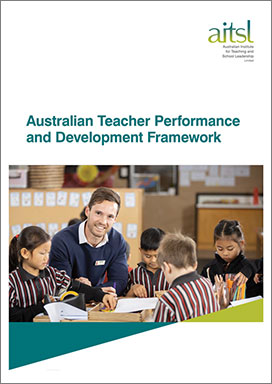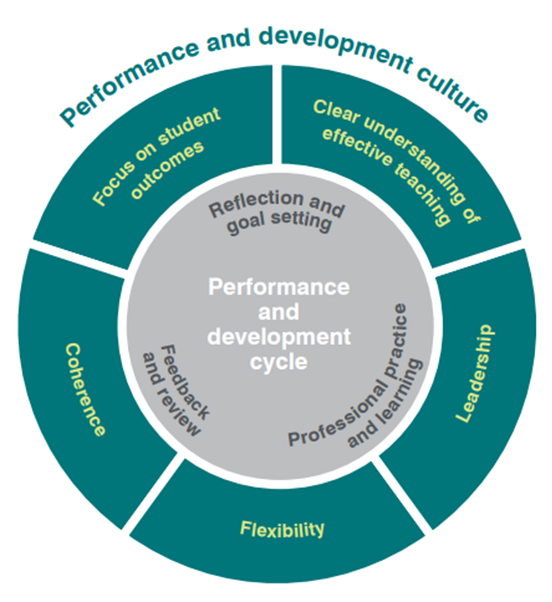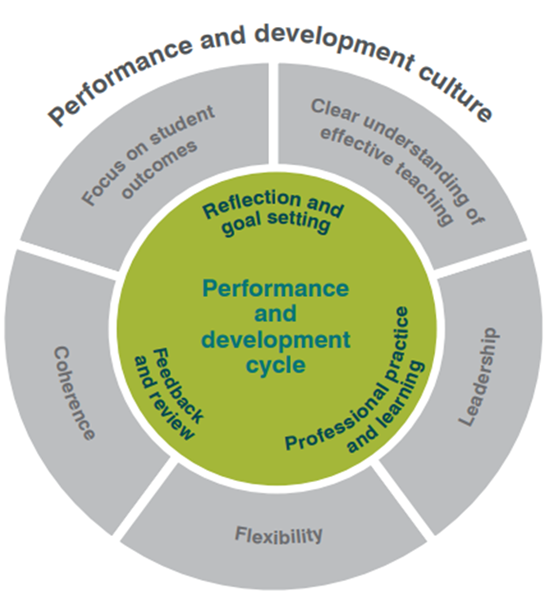Let’s begin
Reflection
What impact would implementing effective performance and development practices have on your education setting?
The Framework is a document that outlines a national approach to support teacher performance and development. It looks at how to build a culture of development – comprised of five components – and the continuous cycle of development, comprised
of three components.

The Framework was developed in collaboration between AITSL and education stakeholders, and is based on research, national mapping and extensive consultation.
In this section we will look at what the Framework says about effective performance and development and how it applies to your education setting.
The Framework outlines the performance and development cycle, and how it sits within a wider performance and development culture. Watch this animation for an overview.
https://www.youtube.com/watch?v=EjMBxxNaboE
Video notes
Reflection
What current development practices are working well in your education setting? What practices could be strengthened?
What parts of the Framework can you already see in action in your education setting?
Research shows that a successful approach to effective performance and development relies on creating a strong and supportive culture in an education setting. The five components of a successful approach to development culture are outlined in dark green
here:

Focus on student outcomes, instead of improving teaching as an end in itself. ‘Student outcomes’ may include learning, engagement, and wellbeing.
Clear understanding of effective teaching, using the Australian Professional Standards for Teachers as a basis and common language.
Leadership, as leaders have a critical and central role in creating the culture. With that said, a truly effective approach has a shared commitment from teachers for their own – and their colleagues’ – development.
Flexiblity, because all education settings have different contexts and histories, and there isn’t a one size fits all approach.
Coherence, as new goals and processes should be consistent with the education setting’s plans and existing approaches.
Reflection
Identify existing processes within your education setting that support the five development culture components.
| Component | Examples |
|---|
| Focus on student outcomes | |
| Clear understanding of effective teaching | |
| Leadership | |
| Flexibility | |
| Coherence | |
A teacher performance and development cycle provides a structure for developing and refining teaching practice. The three components are interdependent and may not necessarily occur in a set order or take equal time, but the cycle provides a useful way
to structure your thinking about it. The components are highlighted in light green here:

Reflection and goal setting, with regular reviews of measurable goals. Goals should align to an education setting’s shared view on effective teaching and should take teacher reflection into account.
Professional practice and learning, meaning teachers will make a conscious effort to collect and reflect on evidence. It should occur in a context of frequent formal and informal feedback.
Feedback and review, with feedback being timely, frequent and improvement focused. There should also be a formal annual performance and development review, including a full reflection on a teacher’s performance against their goals
using multiple sources of evidence.
Reflection
Identify existing processes within your education setting that support the three performance and development cycle practices outlined in the Framework.
| Components | Examples |
|---|
| Reflection and goal setting | |
| Professional practice and learning | |
| Feedback and review | |
Education settings operate in different contexts and will be at different starting points, with differing implementation.
It is in the ongoing work of implementation and culture change that the real challenge lies. A strong commitment from – and extensive support for – education settings, groups of education settings, and teachers and leaders is critical.
Monitoring and evaluation are also essential to sustained and successful implementation.
Reflection
What benefits can you see in implementing the performance and development culture and cycle within your education setting?
What challenges and opportunities can you see in implementing the performance and development culture and cycle within your education setting?
After learning more, is there anything you think would strengthen about your education setting development practices?
Professional Conversations
After spending time reflecting individually, seek out a colleague, mentor or leader to discuss your thoughts. Use the above questions and your responses to help structure the conversation.
Performance and development from multiple perspectives
Watch the video below to hear about the elements of the Framework through the eyes of students, teachers and leaders.
https://www.youtube.com/watch?v=K0CEgHbkZ7I
Video notes
Video intro text, video intro text, video intro text, video intro text
VIDEO TO BE SUPPLIED
Video notes
If you haven’t already completed Module 1 on Understanding the Australian Professional Standards for Teachers, and want to learn more about the Standards, view Module 1.
Resource for leaders
Access videos and stories about real leaders developing leadership using both the Teacher Standards and Principal Standard.
Deepen your understanding with 2b: What is high quality professional learning, and how can it support the development of effective teaching?
Alternatively, return to the professional learning overview page to select another module.